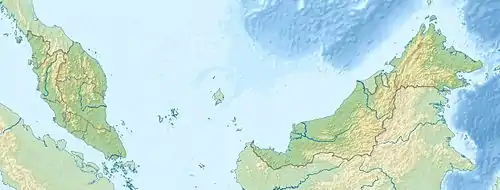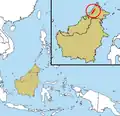Crocker Mountains
Crocker Mountains (Malay: Banjaran Crocker) is a mountain range extending from the West Coast until Interior divisions of Sabah, Malaysia that separates the west and east coast of Sabah. At an average height of 1,800 metres (5,906 ft), it is the highest mountain range in the state. It is named after the British administrator in North Borneo, William Maunder Crocker.[2][3][4]
| Crocker Mountains | |
|---|---|
 Crocker Mountains as seen from Ranau–Tamparuli Road. | |
| Highest point | |
| Peak | Mount Kinabalu |
| Elevation | 4,095 m (13,435 ft) |
| Coordinates | 5°45′N 116°30′E |
| Naming | |
| Etymology | William Maunder Crocker[1] |
| Native name | Banjaran Crocker (Malay) |
| Geography | |
 Crocker Mountains Map showing location of Crocker Mountain range within Malaysia. | |
| Country | Malaysia |
| State | Sabah |
| Region | West Coast and Interior divisions |
| Districts | Beaufort, Keningau, Papar, Penampang, Ranau, Tambunan, Kota Belud, Tuaran and Kota Kinabalu |
Geology
The mountain range is made up of uplifted and folded sedimentary rocks consisting of weathered soft sandstones and shales.[5][6] The highest point is Mount Kinabalu at 4,095 metres (13,435 ft) .[7][8] Most of the park boundary lies above 300 metres (984 ft) with its lowlands used for cash crops and paddy field.[8] On the eastern side of the mountain range lies the Tambunan Valley at 800 metres (2,625 ft) which is mainly terraced paddy fields, and groves of bamboo border the north-eastern part of the protected park.[8] The park area is important as a water catchment to supply water to various rivers in the west coast and interior districts of Sabah including the Papar River, the Kimanis River, the Bongawan River, the Membakut River, the Padas River and the Melalap River that flow west to the park while the Pegalan River, the Pampang River, the Apin-Apin River, the Tendulu River, the Melalap River, the Liawan River and the Tikalod River flow in the opposite direction.[8]
History
The area surrounding Mount Kinabalu has been a state park since 1964 and was the country's first World Heritage Site.[9] Part of the mountain range has been gazetted for protection as Crocker Range National Park since 1984.[10] Through the Bornean Biodiversity and Ecosystems Conservation Programme (BBEC), a technical co-operation existed between the government of Sabah and the Japan International Cooperation Agency (JICA) to innovate the Community Use Zone (CUZ) concept as a management option to address the issues concerning indigenous communities living and utilising resources within the protected areas.[11] Mount Kinabalu, one of the highest mountains in Southeast Asia, is a part of this mountain range. In 2014, the range was recognised as a UNESCO Biosphere Reserve, becoming the second Malaysian site to be so designated, after Chini Lake in the state of Pahang on the peninsular side.[12][13][14]
Biodiversity
The Crocker Mountains Forest Reserve area has a wide range of floral and faunal diversity and has the highest diversity of nocturnal insects in all the 20 forest reserves surveyed within the Heart of Borneo area in Sabah; it has recorded a number of endemic species.[8][15][16]
Gallery
 Map of the mountain range.
Map of the mountain range. The mountain range with a sea of clouds.
The mountain range with a sea of clouds. The mountain range as seen from Ranau District.
The mountain range as seen from Ranau District. View of the mountain range from Ranau–Tamparuli Road.
View of the mountain range from Ranau–Tamparuli Road. The mountain range as seen from Ling San Pagoda in Tuaran District.
The mountain range as seen from Ling San Pagoda in Tuaran District.
References
- Tamara Thiessen (2008). Bradt Travel Guide - Borneo. Bradt Travel Guides. p. 192. ISBN 978-1-84162-252-1.
- James Blaine Kitzmiller (1982). Anopheline Names: Their Derivations and Histories. Entomological Society of America. p. 143. ISBN 978-0-938522-17-1.
- Frederick Halsey Sheldon; Robert G. Moyle; Jody Kennard (2001). Ornithology of Sabah: history, gazetteer, annotated checklist, and bibliography. American Ornithologists' Union. p. 225. ISBN 978-1-891276-24-8.
- Frédéric Durand; Richard Curtis (28 February 2014). Maps of Malaysia and Borneo: Discovery, Statehood and Progress. Editions Didier Millet. p. 180. ISBN 978-967-10617-3-2.
- F. Tongkul; H. Benedick; F. K. Chang (2006). "Geology of slopes in the Crocker Mountains, Sabah, Malaysia" (PDF). Nepal Geological Society. 34 (34): 73–80. doi:10.3126/jngs.v34i0.31881. Archived from the original (PDF) on 13 June 2019. Retrieved 13 June 2019 – via Geology Program, School of Science and Technology, Universiti Malaysia Sabah.
- Muhammad Aqeel Ashraf; Radziah Othman; Che Fauziah Ishak (22 September 2017). Soils of Malaysia. CRC Press. p. 56. ISBN 978-1-351-99857-4.
- "Class VI Virgin Jungle Reserve (VJR) [Infrastructure]". Government of Sabah. 2 April 2005. Retrieved 5 July 2019.
- "Crocker Mountains [Data Zone MY020]". BirdLife International. 2003. Retrieved 27 May 2019.
- Yassin Miki; Daring Laban; Nasrulhakim Maidin; Tengku Zainal Adlin; Maklarin Lakim (19 November 2014). "Crocker Mountains Park: Community Use Zone (CUZ)" (PDF). Sabah Parks: 11. Archived from the original (PDF) on 27 May 2019. Retrieved 27 May 2019 – via Satoyama Initiative, Ministry of the Environment (Japan).
- "Protected Areas of Sabah". Sabah Parks. Archived from the original on 27 May 2019. Retrieved 27 May 2019.
- Ludi Apin; Yassin Miki (15 November 2013). "Community Use Zone of Crocker Mountains National Park, Sabah, Malaysia" (PDF). Sabah Parks. Archived from the original (PDF) on 27 May 2019. Retrieved 27 May 2019 – via Ministry of the Environment (Japan).
- "Sabah's Crocker Mountains recognised as biosphere reserve by Unesco". Bernama. The Malay Mail. 13 June 2014. Retrieved 27 May 2019.
- Muguntan Vanar (17 June 2014). "Sabah's Crocker Mountains approved as biosphere reserve under Unesco". The Star. Retrieved 27 May 2019.
- "Crocker Mountains". Man and the Biosphere Programme, UNESCO. 2014. Archived from the original on 27 May 2019. Retrieved 27 May 2019.
- Arthur Y. C. Chung; Steven Bosuang; Richard Majapun; Reuben Nilus (15 October 2016). "Diversity and Geographical Ranges of Insects in Crocker Mountains Forest Reserve, Sabah, Malaysia". Journal of Tropical Biology & Conservation. Retrieved 27 May 2019 – via Universiti Malaysia Sabah.
- Monica Suleiman; Dunstan Polus Masundang; Hiroyuki Akiyama (11 October 2017). "The Mosses of Crocker Mountains Park, Malaysian Borneo". PhytoKeys (88): 71–107. doi:10.3897/phytokeys.88.14674. PMC 5672137. PMID 29118647.
External links
 Media related to Crocker Mountain Range at Wikimedia Commons
Media related to Crocker Mountain Range at Wikimedia Commons